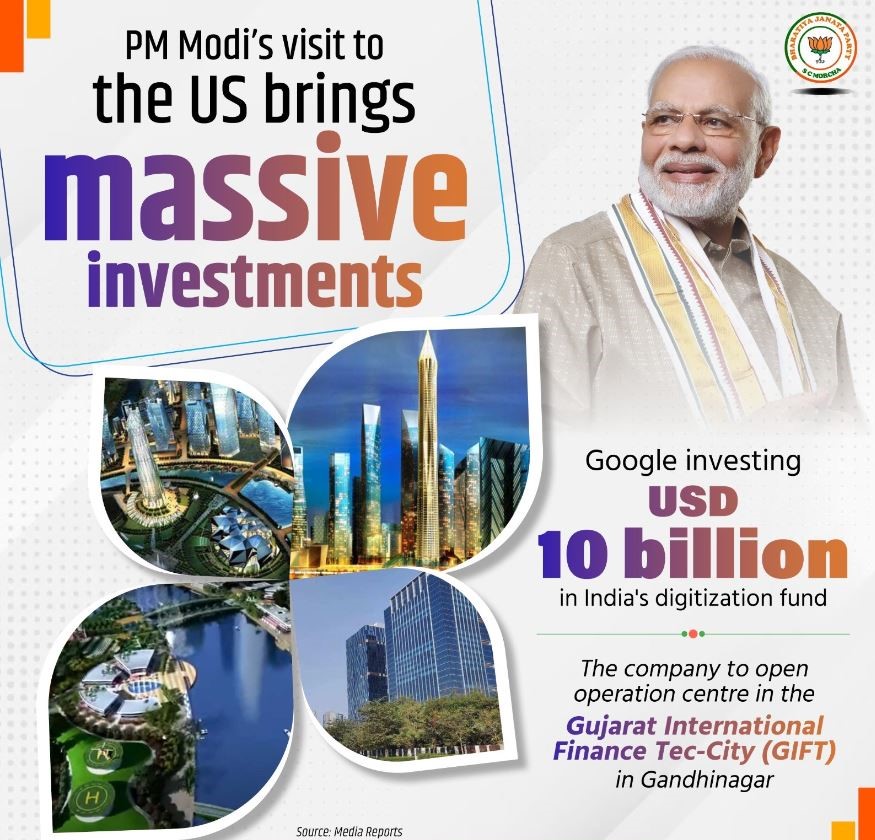In recent years, India has emerged as a force to be reckoned with on the global stage. The world has taken notice and believes that this is the opportune time to invest in India. Under the leadership of Prime Minister Narendra Modi, India has undergone a remarkable transformation, embracing the “Make in India” campaign and positioning itself as a manufacturing hub.
In his address to the nation on 12th May 2020, Prime Minister Narendra Modi unveiled a special economic package for a self-reliant India. He outlined five key pillars to build a self-reliant India: a strong economy, robust infrastructure, 21st-century technology-driven systems, vibrant demography, and the full utilization of domestic demand.
India’s focus on becoming self-reliant has propelled it to strengthen its global position. The “Make in India” initiative has played a pivotal role in this journey, fostering the growth of domestic manufacturing and creating employment opportunities.

Several notable achievements highlight India’s progress:
Expansion of Global Trade
India’s export performance has been nothing short of exceptional, as evidenced by the remarkable growth in goods exports. The country achieved a significant milestone by surpassing the $400 billion mark, with total goods exports reaching a record-breaking $421 billion. This milestone demonstrates India’s increasing competitiveness in the global market and its ability to cater to diverse international demand.
Furthermore, India’s defence exports have also witnessed substantial progress in FY 2022-2023. The cumulative value of defence exports during this period amounted to an impressive Rs 15,920 crore. This significant figure highlights India’s growing presence as a reliable supplier of defence equipment and technology to various nations across the world.

The surge in goods exports and the robust performance in defence exports underline India’s economic resilience and its ability to position itself as a global trade partner. These achievements serve as a testament to the country’s manufacturing capabilities, innovation, and the quality of its products and services.
UPI bringing in Global Payment Revolution
India’s UPI is empowering the whole world by making it easier and cheaper to send and receive money internationally. The Unified Payments Interface (UPI) is a real-time payment system developed by the National Payments Corporation of India (NPCI). It allows users to make instant payments to anyone with a bank account in India, even if they do not have the same bank.
UPI has been a huge success in India, and it is now being adopted by other countries around the world. In 2023, India signed memoranda of understanding (MoUs) with 13 countries that want to adopt the UPI interface for digital payments. Singapore has already completed its UPI integration, and other countries are expected to follow suit soon.
The adoption of UPI by other countries will make it easier for people to send and receive money internationally. This will be especially beneficial for migrant workers, who often have to pay high fees to send money home. It will also be helpful for businesses, who can use UPI to make cross-border payments more easily.
In addition to making it easier to send and receive money, UPI is also helping to promote financial inclusion. In India, UPI has helped to bring millions of people into the formal financial system. This is because UPI does not require users to have a credit card or debit card. All they need is a bank account and a smartphone.
As UPI continues to expand globally, it will have a positive impact on the lives of people around the world. It will make it easier and cheaper to send and receive money, and it will help to promote financial inclusion.
Electronics Exports Surge
The electronics industry in India has achieved remarkable growth and significant milestones in recent years, positioning itself as a key player in the global market. India’s exports of electronic goods have experienced positive and historic growth, reflecting the industry’s robust performance.
In the fiscal year 2022-2023, the electronics industry recorded record-breaking exports, amounting to an impressive Rs 1,85,000 crore. This substantial figure showcases the increasing demand for Indian electronic products and the industry’s ability to deliver high-quality and technologically advanced goods to global markets.
Data from the commerce ministry further emphasizes the sector’s exceptional growth. Comparing April-May 2023 to the same period in 2022, electronics exports witnessed a remarkable surge of 48%, reaching $4.54 billion. This surge demonstrates India’s growing competitiveness in the global electronics market and its capacity to cater to the evolving needs of consumers worldwide.
The success of India’s electronics exports can be attributed to several factors. First and foremost, the country’s strong manufacturing ecosystem, supported by favorable government policies such as the “Make in India” initiative, has facilitated the growth of domestic electronics production. Additionally, the availability of a skilled workforce, technological advancements, and investment in research and development have further fueled the industry’s progress.

India’s electronics exports encompass a wide range of products, including mobile phones, consumer electronics, electronic components, and IT hardware. The industry’s ability to offer diverse and innovative solutions has contributed to its expanding global footprint.
Manufacturing Hub and Global Brands
India’s rise as a favored manufacturing destination has garnered significant attention, with renowned global brands such as Apple and Google recognizing its potential. India has emerged as a second home for iPhone manufacturing, solidifying its position in the global supply chain. In May 2023, a remarkable 80% of smartphones exported from India were iPhones, showcasing the country’s pivotal role in Apple’s production ecosystem.
Moreover, Google, following in Apple’s footsteps, has embarked on diversifying its assembly operations by shifting a portion of its pixel production to India. This strategic move reflects the confidence placed by tech giants in India’s manufacturing capabilities and the country’s conducive business environment.
The decision by Apple and Google to establish a strong manufacturing presence in India is attributed to several key factors. First and foremost, India offers a vast pool of skilled labor, enabling efficient production processes. The availability of technically proficient workers and engineers, combined with India’s focus on research and development, aligns well with the intricate demands of electronic manufacturing.
Additionally, the Indian government’s proactive initiatives, such as the “Make in India” campaign, have created an enabling environment for manufacturing companies. These initiatives promote ease of doing business, provide incentives, and streamline regulations, making India an attractive investment destination.
Furthermore, India’s large domestic market, coupled with its strategic geographical location, provides access to a significant consumer base and favorable logistical opportunities. By establishing production facilities in India, global brands can cater to the growing domestic demand while leveraging India’s robust supply chain for regional and global exports.
Advancements in Defence and Technology Sectors
India’s commitment to enhancing its defence capabilities has led to significant advancements, propelled by strategic deals and collaborations. One such milestone is the approval of a substantial $3 billion plan to acquire 30 lethal Predator Drones. This move reinforces India’s defence infrastructure and adds critical firepower to its armed forces, bolstering the nation’s capabilities in countering cross-border threats and maintaining national security.

The Defence Research and Development Organisation (DRDO) has played a pivotal role in bolstering India’s defence capabilities with several noteworthy Made in India achievements. Among its remarkable accomplishments are the development of the BrahMos supersonic cruise missile, which stands as one of the fastest missiles globally. Additionally, the Akash surface-to-air missile system has proven to be an exceptionally effective air defence solution. The Nag anti-tank guided missile, with its high accuracy and lethal capabilities, has been another stellar contribution. Furthermore, DRDO’s development of the state-of-the-art Arjun tank and the indigenously built Light Combat Aircraft (LCA), a versatile single-engine fighter aircraft, have added significant strength to India’s defence capabilities.
These are only a glimpse of the many triumphs achieved by DRDO, solidifying India’s position as a self-reliant and robust defence power. By continually advancing indigenous technologies and innovations, DRDO has played an indispensable role in enhancing the nation’s security and preparedness on the global stage.
Additionally, India has embarked on a landmark co-production agreement with General Electric for the F414 jet engines. This collaboration signifies a significant leap forward in India’s indigenous defence manufacturing capabilities. The co-production of these advanced engines through a partnership between General Electric and India’s Hindustan Aeronautics Limited (HAL) empowers the Indian Air Force’s LCA Mk2 program and strengthens the country’s aerospace industry.
In tandem with advancements in the defence sector, India’s technology landscape has also experienced a notable boost. Micron Technology’s announcement of a $2.7 billion investment in a semiconductor testing and packaging plant in India reflects the country’s growing prowess in the technology sector. This significant investment reinforces India’s position as a preferred destination for high-tech manufacturing and reinforces its objective to become a global hub for semiconductor production.

These transformative developments in defence and technology signify India’s progressive outlook and commitment to self-reliance. They highlight India’s determination to bolster its self-reliance agenda, enhance its global standing, and reinforce its position as a hub for cutting-edge defence technologies and advanced manufacturing.
Infrastructural Development and Shipbuilding
India’s steadfast commitment to infrastructure development is prominently demonstrated through notable projects that drive economic growth and strengthen the nation’s capabilities. One such instance is the Udupi Cochin Shipyard Limited’s recent order valued at Rs. 580 crores. This substantial contract entails the construction of six cutting-edge diesel-electric cargo vessels, representing India’s ambitions to enhance its maritime infrastructure and bolster its shipping industry.

The order highlights India’s dedication to modernizing its shipbuilding capabilities, fostering domestic manufacturing, and expanding its presence in the global maritime market. By investing in advanced vessels, India aims to enhance its cargo transportation capacities, improve logistics networks, and facilitate efficient trade connectivity both domestically and internationally.
Furthermore, India has set its sights on becoming a global manufacturing hub for drones by 2030. This forward-looking vision underscores India’s ambition to leverage emerging technologies and capitalize on the immense potential of the unmanned aerial vehicle (UAV) industry. By fostering a robust drone manufacturing ecosystem, India aims to enhance its surveillance capabilities, support disaster management efforts, revolutionize various sectors such as agriculture and logistics, and bolster the country’s defence capabilities.
Foreign Investments and Market Access
Global giants like Google have recognized India’s immense potential and have made substantial investments in the country, further solidifying India’s position as a preferred destination for business and innovation. Google’s strategic investments in India include the establishment of a global fintech operation centre in Gujarat. This move highlights India’s growing significance in the financial technology sector and positions the country as a hub for cutting-edge digital financial services.

The opening of Google’s fintech operation centre in Gujarat not only brings employment opportunities but also fosters technological advancements, promotes financial inclusion, and supports India’s vision of a digitized economy. This investment underscores Google’s confidence in India’s talent pool and the country’s conducive business environment.
In addition to attracting investments from global giants, India has also signed historic trade deals with countries such as Australia, the UAE, and Mauritius. These trade agreements have opened up new avenues for economic cooperation, facilitated bilateral trade, and strengthened diplomatic ties.
One significant aspect of these trade deals is the provision of zero-duty market access to the labor-intensive sector. This initiative promotes trade and encourages investments in industries that heavily rely on labor, creating employment opportunities and stimulating economic growth. By granting zero-duty access, India attracts foreign companies to establish manufacturing facilities, thereby boosting the manufacturing sector and supporting the country’s self-reliance goals.
These trade agreements serve as a catalyst for economic diversification and mutual growth. They facilitate the exchange of goods, services, and technology, fostering collaboration and knowledge-sharing between nations. The increased market access provided by these agreements enhances India’s competitiveness and promotes trade diversification, ultimately leading to the expansion of export-oriented industries and the overall growth of the Indian economy.
Moreover, these trade deals signify India’s commitment to fostering a favorable business environment and attracting foreign investments. The agreements demonstrate India’s willingness to engage in global trade partnerships and its proactive approach to creating win-win scenarios for both Indian and international businesses.
India’s journey towards self-reliance and its global ascension is fueled by determined efforts, visionary leadership, and strategic collaborations. As India embraces a more prominent role on the global stage, the world recognizes the vast opportunities it presents for investment and mutually beneficial partnerships.








